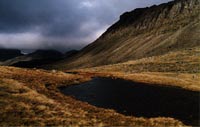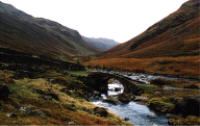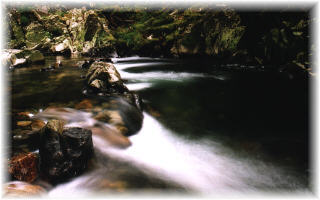THE HIGH FELLS OF UPPER ESKDALE
At the head of Eskdale is the crown of the Lake District's fells - an awe-inspiring circle of crags, buttresses and pinnacles that includes England's highest mountains. It is well known as a place for adventure and challenge, but its changeable moods and quiet solitude have also inspired poets and artists throughout the centuries.

Upper Eskdale really starts at the Woolpack Inn, once the place of shepherds' 'meets' and the last place of rest and refreshment on the packhorse track. It is here that the steep shoulders of Scafell finally relent and give way to the granite outcrops and nestling tarns that characterise Mid-Eskdale. Across the valley the perfectly proportioned form of Harter Fell is the last defiant thrust of the high fells.
The steep incline of Hardknott Pass is often regarded as the top of the valley, but this is simply the point at which the road builders, from the Romans onwards, got out while they could. The valley continues for another 5 miles before the source of the Esk is reached, high on Esk Hause. The head of the valley can be reached, with moderate effort, from Brotherilkeld Farm, but if you do not feel able to go the full distance there are plenty of other objectives on route. The first few miles are quite gradual, with Heron Crag, home to a pair of falcons, on your left and the lofty pyramid of Bowfell ahead. Near the old packhorse bridge, at Lingcove, are the deep pools and cascades of Tongue Pot, and beyond, the path steepens and narrows into the gorge above Esk Falls. The track to the right of the bridge clambers up the side of Lingcove Falls, before settling into the lovely approach path to Bowfell and Crinkle Crags.
Gradually, the high mountains reveal themselves. First, the dark curtain of Cam Spout Crag, with the white ribbon of its waterfall, and Scafell, rising majestically above. Then, the massive shape of Scafell Pike and its buttress, Dow Crag - a rock climbers paradise. The forbidding spire of Ill Crag is the next point on this encircling skyline. Finally, the top of Esk Pike, hidden by its rocky flanks, comes into view. In striking contrast the valley floor here is soft and mellow - the deep russets and greens of sedge and moss - with the River Esk gently meandering around the edge. Peregrine falcons and soaring crags; waterfalls, pools and jewel-like tarns; and the finest mountains in England.

For all the beauty of this landscape, and the joy of walking on the fells, the true, unsung heroes of Upper Eskdale are the farmers and their Herdwick sheep. People talk of the 'natural beauty' of the Lakes, but much of what we see in the valleys today is the result of over 1000 years' skilful land management. There has been a farm at Brotherilkeld since the first Norse settlers cleared the valley floor, and the present farm has been with the same family for more than 400 years. The Herdwicks, too, were thought to have been brought over by the Vikings, although some claim that they are indigenous, and other people believe they came from the Armada wrecks. Whatever their origin, the Herdwicks are ideally suited to the harsh, cold and wet conditions and can be considered as the rightful heirs to these high fells.

Mid Eskdale
While Upper Eskdale is a hidden world of wild grandeur, Mid-Eskdale is a gentler, contrasting landscape. Here the valley floor is a patchwork of green fields and wooded knolls, bordered by high outcrops of pink granite, and with the ever-present Esk providing a playful link to the scene. Mid-Eskdale, which is generally defined as running from the Woolpack Inn to Eskdale Green, was described quite simply by Wainwright as 'a walker's paradise' - no other epithets seem necessary. It is an area of head-spinning beauty but also one of great variety and interest. Nearly all of the valley and the surrounding fells are accessible, and criss-crossed with paths, which means that, even in the summer months, you can stride out for miles without seeing a soul.
There is a place, or a walk, for everyone. Dalegarth Falls offers a wooded ravine with the high drama of Lakeland's loveliest waterfall. The winding track up from Beckfoot to Blea Tarn may be steep in parts but who is rushing? - look back at that view across the valley. For lovers of space and wind-ruffled panoramas, take one of the paths from the old Corn Mill at Boot, past the peat huts and stone circles, over to Burnmoor Tarn, or pause for a while to watch the sun-dappled cascades of Whillan Beck.

Gnarled oaks and red squirrels, white cascades and millers' tales, Giggle Alley, Peelplace Noddle and more to Boot.
For a pleasant woodland round, visit the curiously named Giggle Alley in Eskdale Green, which, as well as its large collection of trees and ferns, also has numerous flights of stone stairs and a Japanese Garden - if you are still you may well catch sight of some red squirrels and roe deer. For a relaxing stroll, the River Esk has footpaths all the way from Forge Bridge up to Hardknott, with numerous bridges in between. There are quiet pools to paddle in; deep gorges and plunging pools; flat slabs to stretch out on; and sufficient scenes to keep artists sharpening their pencils for months.
Mid-Eskdale is not just a place of great natural beauty, it is also a place of warmth and welcome. This may be a reflection on the good-natured farming community, or the fact that the area has five friendly inns - normally a good indicator of 'bonhomie'. It is a welcome found over an evening pint, beside a roaring log fire, or when asking for directions at The Village Stores. You will find it at the Art Show, the Hounds Open-Day and the Eskdale Show. And you will find it at the churches to such an extent that you may well be on the readers' list for the following Sunday. If the day is beginning to cloud over, or if you just fancy a break from the fells, there is still plenty of interest .
Eskdale Mill predates a survey taken in 1578, and is one of the few remaining 'two wheel' water mills. It was owned by the Stanleys of nearby Dalegarth Hall and, later, by several generations of the Hartley family. As well as the exhibition, you can explore the workings of its unique wooden machinery or picnic beside the mill-race.
Fold End Gallery is two minutes walk away and has an array of paintings, pottery and affordable reminders of your visit, or a present for the forthcoming birthday.
La'al Ratty, the famous miniature steam train, runs as far as Dalegarth Station, five minutes walk from Boot. So scramble aboard and make a day of this wonderful way of seeing Eskdale, combined with a visit to Muncaster Castle, the Owl Centre and a walk to the Roman bath house in Ravenglass. You should get back in time for an afternoon tea at Dalegarth, where refreshed and relaxed you can unfold the map and plan tomorrow's bike ride.